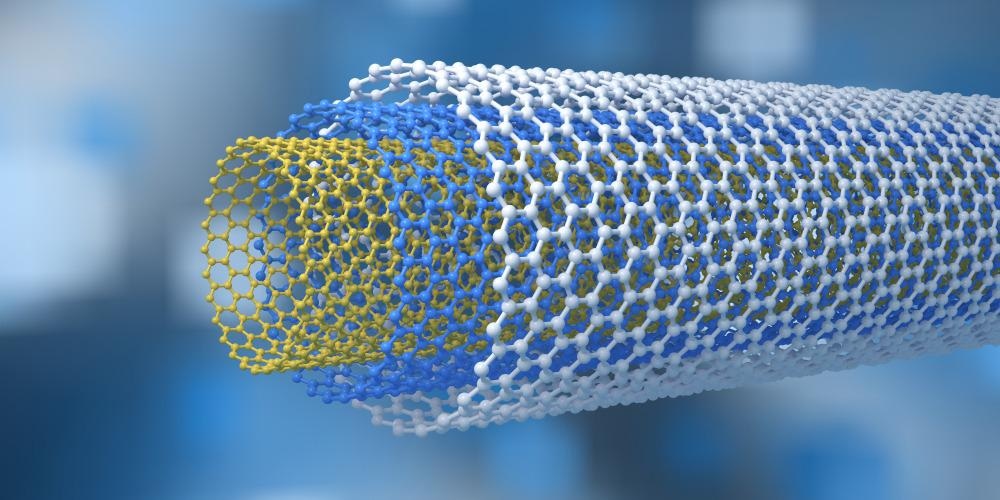Exposure to natural or artificial electromagnetic radiation can harm living organisms as well as sophisticated electronic components.

Image Credit: ustas7777777/Shutterstock.com
With the widespread use of electrical and electronic systems in our everyday lives, electromagnetic interference (EMI) shielding becomes essential to protect human health and ensure safe device operation across a broad range of commercial, industrial, and military activities.
In that respect, carbon nanotubes (CNTs), owing to their unique electronic properties, have shown a great potential for use in EMI shielding nanocomposite materials and radiation-tolerant microelectronic components.
Natural background radiation on Earth is inescapable and mostly harmless. However, the levels of radiation exposure originating from human technology are constantly increasing and are considered damaging.
Depending on the wavelength, electromagnetic radiation can be divided into gamma rays, X-rays, UV, visible light, infrared, microwave, and radio waves. High-energy electromagnetic radiation, such as gamma rays and X-rays, is also categorized as ionizing radiation, as it causes the formation of charged particles when absorbed in matter.
Technological developments Cause Electromagnetic Pollution
Over the last century, human technology, such as nuclear reactors, medical imaging, wireless telecommunication, space flights, and many others, dramatically increased our exposure to radio waves and, in many cases, to ionizing radiation.
The rapid technological developments and the resulting electromagnetic pollution instigate concerns not only about the effects of radiation on human health but also regarding the degradation of the performance of a wide range of electronic equipment.
Sensors, communication units, remote sensing instruments, computers, transformers, medical devices, and many others, both onboard spacecraft and Earth, can be disturbed or damaged by undesirable EMI.
Preventing Damage from High-Energy Radiation
Effective EMI shielding materials combined with radiation-tolerant electronic components can eliminate the adverse effects of electromagnetic radiation. In the past, metallic materials, such as copper, aluminum, and steel, have been used as effective shielding materials because of their high electrical conductivity and good permeability. However, these materials are disadvantageous in terms of weight and flexibility as many modern applications, like space exploration, wearable electronics, and biomedical sensing, require smaller and lighter devices.
Nanocomposite Materials for EMI Shielding
Polymer nanocomposites that incorporate CNTs have emerged as an alternative to conventional EMI shielding materials due to their remarkable electrical properties, lightweight, and flexibility. Owing to their high specific surface area, the CNTs can effectively form a dense conductive network when dispersed in a polymer matrix, resulting in a highly-conductive material.
Structurally similar to graphene, CNTs consist of carbon atoms arranged in a long-range hexagonal lattice of monatomic thickness, which presents a long-range pi-conjugated system (connected p-orbitals with delocalized electrons).
Such molecular systems are highly tolerant to high-energy radiation since the absorbed energy can spread over the whole system and dissipate rapidly.
Lightweight CNT-Based Materials for Radiation Protection
In the last decade, many research groups have explored the unique properties of the CNT-based nanocomposites and their application as flexible and lightweight radiation shielding materials and fabrics. Besides the ability to absorb and dissipate electromagnetic radiation, such nanocomposites exhibit outstanding mechanical properties and excellent processability.
Currently, CNT-based nanocomposites are increasingly used as lead-free X-ray and microwave EMI shielding materials in a wide range of applications, such as spacecraft design, telecommunications, and personal protective equipment for biomedical imaging.
Redesigning the Traditional Semiconductor Devices
An alternative approach to radiation shielding is to create radiation-tolerant electronic devices capable of withstanding a continuous stream of damaging radiation that can harm or even destroy onboard electronics during a deep-space exploration mission or when operating in nuclear reactors.
According to scientists from the Massachusetts Institute of Technology, single-walled CNTs might be the answer to that challenge. With support from the Air Force Research Laboratory in the USA, the researchers built memory chips based on field-effect transistors (FETs), where CNTs deposited on a silicon wafer served as a semiconducting layer.
CNTs Make Transistors More Radiation-Tolerant
By testing different configurations of the CNT-based FETs, the research team discovered that when the semiconducting channel (formed by the CNTs) was complemented by metal gate layers fabricated on top and underneath the entire length of the channel, the novel FETs exhibited stable operation even at extremely high doses of absorbed radiation above 10 Mrad (a significantly higher than the critical dose for the traditional silicon-based electronics).
To demonstrate the novel technology's fabrication simplicity and radiation robustness, the research team created static random-access memory (SRAM) chips by using the CNT-based FETs.
The whole-wafer-sized devices performed similarly to the individual transistors, with a similarly high X-ray radiation threshold. The researchers envisage that the new strategy would enable the realization of FETS and integrated circuits that are much less susceptible to radiation-related damage.
The newly-developed CNT-based FETs could be a promising route toward next-generation electronics for space exploration and other high-level radiation applications.
Continue reading: Carbon Nanotube Nanocomposite Ink for Additive Manufacturing.
References and Further Reading
ACS Nano (2021) Carbon nanotubes could help electronics withstand outer space’s harsh conditions [Online] www.acs.org Available at: https://www.acs.org/content/acs/en/pressroom/newsreleases/2021/october/carbon-nanotubes-could-help-electronics-withstand-outer-spaces-harsh-conditions.html
Kanhaiya, P. S., et al. (2021) Carbon Nanotubes for Radiation-Tolerant Electronics. ACS Nano, Article ASAP. Available at: https://doi.org/10.1021/acsnano.1c04194
Acevedo-Del-Castillo, A., et al. (2021) A Brief Review on the High-Energy Electromagnetic Radiation-Shielding Materials Based on Polymer Nanocomposites. Int. J. Mol. Sci., 22, 9079. Available at: https://doi.org/10.3390/ijms22169079
Zhu, M., Xiao, H., Yan, G., et al. (2020) Radiation-hardened and repairable integrated circuits based on carbon nanotube transistors with ion gel gates. Nat Electron 3, 622–629. Available at: https://doi.org/10.1038/s41928-020-0465-1
Dassan, B., et al. (2020) Carbon nanotube–reinforced polymer composite for electromagnetic interference application: A review. Nanotechnology Reviews, 9, 768-788. Available at: https://doi.org/10.1515/ntrev-2020-0064
Disclaimer: The views expressed here are those of the author expressed in their private capacity and do not necessarily represent the views of AZoM.com Limited T/A AZoNetwork the owner and operator of this website. This disclaimer forms part of the Terms and conditions of use of this website.